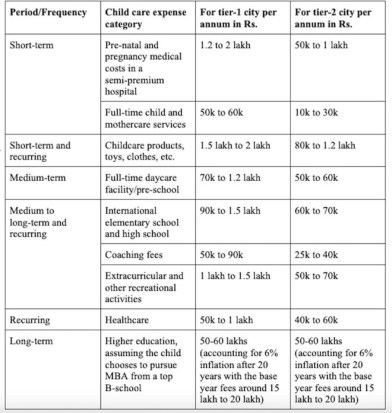Father’s Day is just around the corner. It is a special day that is celebrated to honour the superheroes who love and sacrifice every day to shape their child’s future and fulfil their every wish and aspiration.
Becoming a father is one of the significant milestones in life, which needs careful consideration of many factors, especially financial preparedness. There are various expenses related to raising a child, including education, healthcare, extracurricular activities, and other miscellaneous expenses. With time, as the cost of living increases, these expenses also go up.
While you cannot measure the joy of fatherhood in monetary terms, it is essential to have a solid financial foundation to ensure a stable and comfortable upbringing for your child. If you are planning to enter this new phase of life, here is how to plan your finances for the different life stages of your child.
Cost of raising a child
It is not an easy task to raise a child. As inflation increases, it also increases various expenditures associated with a child’s upbringing. This can be divided into two categories:
- Short-term expenses: These include expenses associated with pre-natal and pregnancy expenses, childbirth hospitalisation and post-hospitalization costs, and other expenses such as baby and mothercare services and products, in addition to basic childcare needs. These are expenses you can expect till your newborn turns into a toddler.
- Medium to long-term expenses: This includes expenses such as enrolling in a daycare or preschool, elementary and higher education costs, tuition fees, extracurricular or recreational activities, healthcare expenses, and more.
If you are planning for fatherhood, you can enjoy some liberty of time to plan for long-term expenses such as higher education. However, for short-term expenses, you need to make provisions beforehand. These expenses can vary depending on your preferences and geographical location, i.e. in metro or tier-1 cities, childcare expenses and hospitalisation costs are likely to be higher compared to tier-2 cities or small towns.
Here is an estimate of the approximate costs for raising a child in a tier-1 and tier-2 city:

Summing up these expenses, you need to have funds in this range:
| Period | Total expense for tier-1 city | Total expense for tier-2 city |
| Short-term | Rs. 3.2 lakh to 4.6 lakh | Rs. 1.5 lakh to 2.5 lakh |
| Medium to long-term and on a recurring basis | Rs. 3.6 lakh to 6.1 lakh | Rs. 2.25 lakh to 3 lakh |
| Long-term | Rs. 50 lakh to 60 lakh | Rs. 50 lakh to 60 lakh |
The location of raising the child matters the most in determining the total cost. It is likely to be lower for tier-2 cities, small towns and villages compared to tier-1 cities or metros; for instance, it would be higher in Mumbai compared to Bhopal. Also, the total cost differs based on individual preferences and choices.
Also Read: Self-employed? Here is how you can build a good credit score
Note that here we haven’t added other expenses, such as fertility clinic services in the short term and lifestyle and wedding-related expenses as your child grows. Also, if your child wishes to pursue higher education abroad, it can add up to the total corpus you will need in the long run.
While these expenses may seem overwhelming, you can efficiently manage them by prioritising savings and planning investments in advance. You can also adopt the approach of Income – Savings = Expenses instead of Income – Expenses = Savings.
Invest for your child’s financial future
You can start by breaking down your investment goals for your child’s life stage. Based on your preferences and risk profile, make a decision.
To save in the short term, you can start by putting aside a certain sum every month in fixed-income instruments such as a recurring deposit, bank FDs, post office schemes, bonds, etc. You can also leverage government investments such as Mahila Samman Savings Certificate, where you can invest under your wife’s name.
In the medium to long term, you can invest in equity-weighing instruments, including stocks, mutual funds, ETFs, and more. However, consulting a certified financial advisor is recommended for investing in mutual funds, stocks and other market-related instruments.
Also Read: Health insurance: A critical illness plan is a must buy
Ideally, you should ensure there is enough diversification in your investment portfolio among different asset classes. Adding debt tools and alternative investments can be helpful in reducing the correlation with the market risk of adding equity to your portfolio.
Additionally, because most of the expenses in the medium to long term are likely to be recurring, you need to plan investments in a way that can provide you liquidity or withdrawal facility as and when needed without penalties. For example, some funds offer money-back plans after the completion of certain investment tenure, i.e. every 3 years.
Lastly, it is imperative to consider healthcare expenses. While most kids are not prone to non-communicable diseases, they are often reckless and prone to injuries. This can unexpectedly impact your monthly budget. To avoid this, get a health insurance plan for your child or include him/her in your family floater plan.
The bottom line
It is never an overstatement to say that “The power of a dad in a child’s life is unmatched.” As you plan your journey to becoming a father, remember that it comes with responsibilities. By planning and managing finances wisely, you can secure your child’s hopes and dreams and become the best version of yourself along the way. Wishing all the superheroes out there a Happy Father’s Day!
This article has been written by Devanshee Dave, Personal Finance Content Specialist.
Disclaimer: The views and suggestions mentioned here are those of the respective commentators. The facts and opinions expressed here do not reflect the views of www.financialexpress.com. Please consult your financial advisor before investing.

